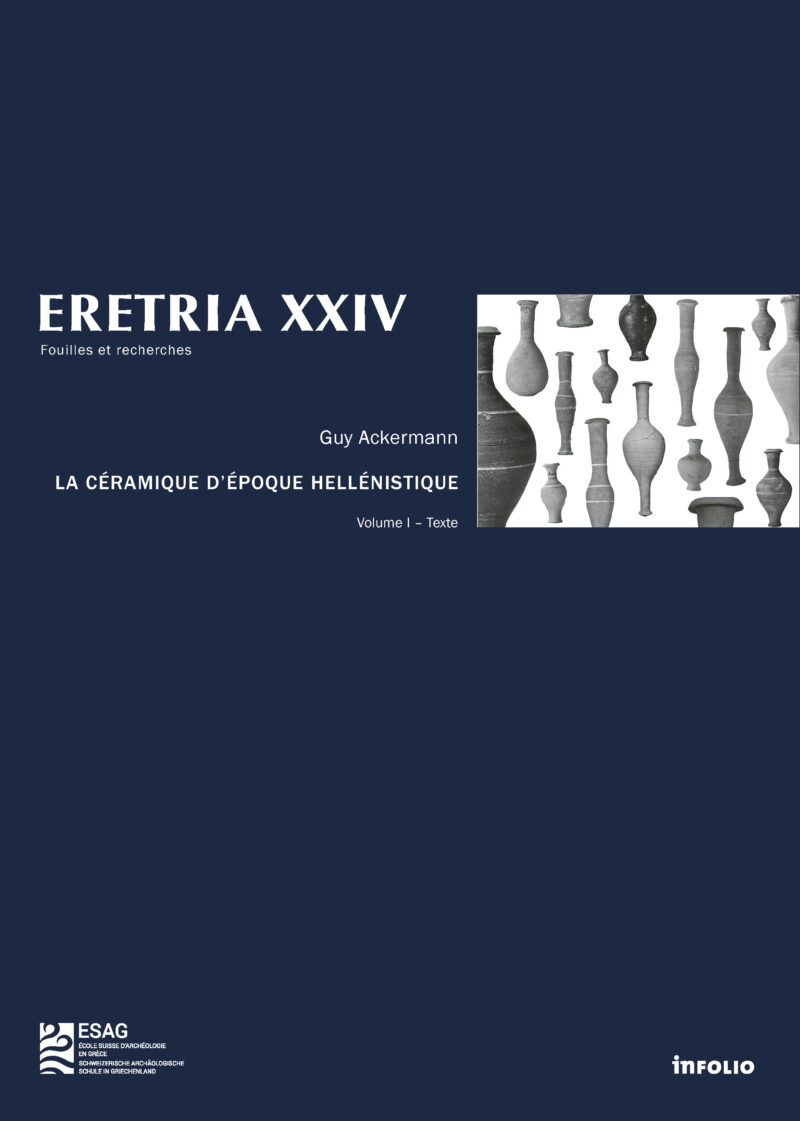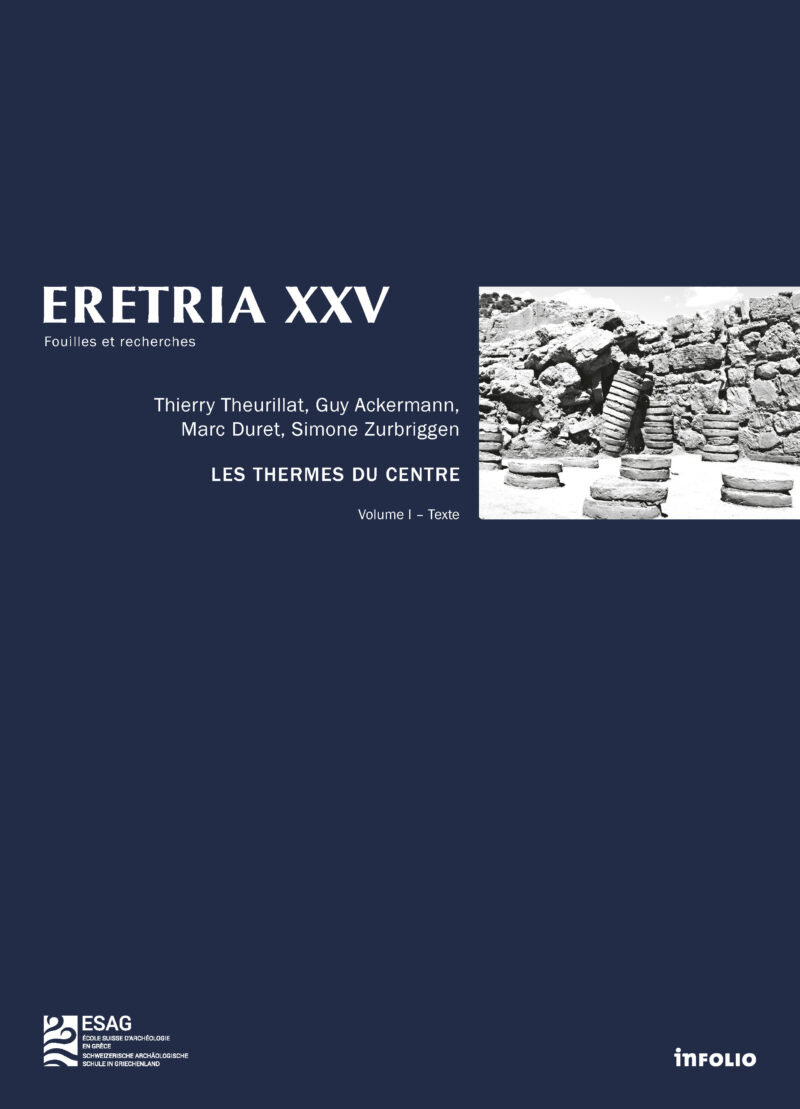New releases: ERETRIA XXIV & XXV
The ERETRIA series
Since 1964, Swiss archaeologists excavate and study ancient Eretria (Euboea island). The ERETRIA series present the final results of the main excavations and discoveries of the Swiss School of Archaeology in Greece.
ERETRIA series homepageERETRIA XXIV (2020)
Guy Ackermann, La céramique d’époque hellénistique. Une chrono-typologie au service de l’histoire d’une ville grecque entre la fin du IVe et le Ier siècle av. J.-C.
With its sanctuaries, public monuments, residential areas and fortifications, Eretria is one of the most thoroughly explored cities in the ancient Greek world. Since the end of the 19th century, excavations have brought to light numerous remains, in particular an abundant pottery of the Hellenistic period, which is the focus of this study.
The author has revisited a number of closed contexts dated from the end of the 4th to the middle of the 1st century B.C. He proposes a chrono-typology of the ceramic repertoire in use in Eretria during the Hellenistic period.
The comparative analysis of local production and imports allows a better understanding of the economy of the city. The Eretrian market is characterised both by self-sufficiency, with local workshops meeting the bulk of the population’s demand, and by its insertion into the trade networks. The potters quickly adopted the innovations coming first from Athens and Macedonia, then from Asia Minor and the East.
A reviewed chronology of closed contexts (destruction layers, filling of wells and pits, monetary treasures) allows the author to propose a new history of the city and its progressive decline: to a densely populated settlement until the middle or second half of the 3rd c., it evolved into a sparse dwelling with large stretch of the urban area left in ruins before the occupation moved on the acropolis in the middle of the 1st c. BC. Several residential quarters were severely damaged in the middle of the 3rd century and in 86 BC, but the sieges of 267 and 198 BC were clearly not as devastating as has been claimed so far.
2020, 2 vol. of 264 and 272 pages in French with abstracts in French, German, English and Greek, Paperback, 22x30cm, numerous color illustrations and plans. Infolio editions, Gollion.
ISBN 978-2-88474-413-3
About the author
Guy Ackermann holds a PhD degree from Lausanne University and is currently a member of the French School of Athens with a fellowship of the Swiss National Science Foundation. He directed the excavation of the Gymnasium in Eretria (2015–2019) and co-authored the recently published volume on the Roman Baths in Eretria (Eretria XXV, 2020).
Guy.Ackermann@efa.gr
ERETRIA XXV (2020)
Thierry Theurillat, Guy Ackermann, Marc Duret and Simone Zurbriggen, Les thermes du centre
ERETRIA XXV presents the study of Roman baths excavated by the Swiss School of Archaeology in Greece between 2009 and 2014 in Eretria (Euboea, Greece). Built shortly after the middle of the 2nd century AD at the center of the ancient city, these small-scale thermae conform to the traditional layout and include the characteristic rooms of the Roman bathhouses of the Imperial period. Several nearby kilns were used to produce lime for the construction of the baths. Converted into a rubbish dump after they were taken out of service, they yielded a rich assemblage related to the use of the baths. The abandonment of the bathing building took place shortly after the middle of the 3rd century AD, as evidenced by a treasure of 201 Antoninians hidden in the sewer of the baths. The book concludes with a discussion on the Imperial period in Eretria, bathing practices and their evolution as well as thermal baths in Greece.
With contributions by Benoît Dubosson (mosaics), Laureline Pop (sculpture), Marek Palaczyk (transport amphorae), Solange Bernstein (lamps), Brigitte Demierre Prikhodkine (glass and limekilns), Sofia Raszy and Benoît Pittet (small finds), Marguerite Spoerri Butcher M. (coins), Tatiana Theodoropoulou (maritime faunal remains), Angelos Gkotsinas (terrestrial faunal remains), Evi Margaritis and Clémence Pagnoux (plant remains), Arnaud Coutelas (mortar analysis), Despoina Kondopoulou, Irene Zananiri and Gwenaël Hervé (archaeomagnetic study).
2020, 2 vol. of 232 and 172 pages in French, German and English with summaries in French, German, English and Greek, Paperback, 22x30cm, numerous color illustrations and plans. Infolio editions, Gollion.
ISBN 978-2-88474-414-0
About the authors
Thierry Theurillat is the Scientific secretary of the Swiss School of Archaeology in Greece. He directed the excavation of the Roman baths in Eretria from 2009 to 2014 and the related publication.
Guy Ackermann is a member of the French School of Athens. He is the author of a volume in the Eretria collection on Hellenistic pottery from Eretria (Eretria XXIV, 2020).
Marc Duret is a specialist in trade relations in the Roman period.
Simone Zurbriggen conducts research on the Roman pottery from Eretria as part of her doctoral thesis at the University of Basel.

